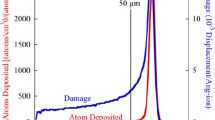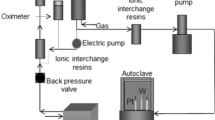Abstract
The fuel claddings in the Pressurised Water Reactor are corroded in water at high temperature and high pressure. The technical device ableto follow continuously the corrosion rate in conditions close to this medium does not yet exist. That is the reason why a high pressure thermogravimetric installation based on magnetic suspension has been designed to study in situ the oxidation kinetics of the zirconium based alloys under water vapour until 50 bars of pressure at 415°C. The accuracy of measurements is about 5·10−5 g under 2 bars, and 10−4 g under 50 bars. The reproducibility of measurements was verified and the deviation regarding post test weighing at room temperature is around 5·10−5 g what is clearly satisfying. Finally, the results presented in this work allow validating the high pressure thermogravimetric measurements obtained with this magnetic suspension device.
Similar content being viewed by others
References
B. G. Parfenov, V. V. Gerasimov and G. I. Venediktova, Corrosion of zirconium and zirconium alloys in Myers, New York 1967, p. 9.
B. Cox, J. Nucl. Mater., 336 (2005) 331.
E. Hillner, Hydrogen absorption in Zircaloy during aqueous corrosion, Effect of Environment, U.S. Rep. WAPD-TM-411, Bettis Atomic Power Lab, Pittsburgh 1964.
International Atomic Energy Agency, Waterside Corrosion of Zirconium in Nuclear Power Plants, IAEA-TECDOC-996, IAEA, Vienna 1998, p. 37.
P. Kofstad, High temperature corrosion in Elsevier Publishing, London-NewYork 1988, p. 299.
M. Tupin, M. Pijolat, F. Valdivieso, M. Soustelle, A. Frichet and P. Barberis, J. Nucl. Mater., 317 (2003) 130.
N. Pétigny-Putigny, Comparaison de l’oxydation de deux alliages à base de zirconium par diffraction des rayons X in-situ et ex-situ: texture, phase, contrainte, PhD thesis, Université de Bourgogne, Bourgogne 1998.
Th. Gast and W. Pahlke, J. Thermal Anal., 37 (1991) 1933.
Th. Gast and E. Robens, J. Thermal Anal., 47 (1996) 605.
C. A. Meyer, ASME Steam Tables in American Society of Mechanical Engineers, New York, 1983.
P. Sarrazin, A. Galerie and J. Foultier, Les mécanismes de corrosion sèche une approche cinétique in EDP Science, Paris, 2000, p. 44.
Author information
Authors and Affiliations
Corresponding author
Rights and permissions
About this article
Cite this article
Dali, Y., Tupin, M., Bossis, P. et al. Application of a magnetic suspension balance to the oxidation study of the zirconium based alloys under high pressure water vapour. J Therm Anal Calorim 96, 155–160 (2009). https://doi.org/10.1007/s10973-008-8901-x
Received:
Accepted:
Published:
Issue Date:
DOI: https://doi.org/10.1007/s10973-008-8901-x




